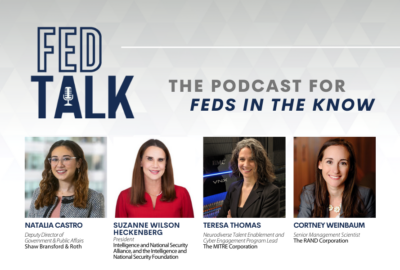Federal neurodiversity playbook pushes inclusive hiring, retention practices
The new edition of the "Neurodiversity @Work" playbook takes best practices and helps apply them to the world of federal workforce policies.
Some agencies have been piloting neurodiversity initiatives in recent years, but the entire federal government now has a playbook to help find talent and create opportunities for people with autism and other neurodivergent conditions.
In May, the University of Washington, MITRE and DC-based nonprofit Melwood released the Neurodiversity@Work Playbook: Federal Edition. Teresa Thomas, MITRE’s program lead for neurodiverse talent enablement, said the playbook should help federal agencies with questions about how to establish workforce practices that embrace neurodiversity.
“It is a tool for agencies that really want to think through neuro-inclusion in a systemic sort of way,” Thomas said in an interview. “And to give them the tools that they need to know what to ask, to know who [and] to ask to know where to go. And to remind them of the things they need to not forget.”
The authors of the playbook also say agencies can help fill workforce gaps by adopting more inclusive hiring practices. Scott Gibson, Melwood’s chief strategy officer, said that the federal workforce is getting older. And federal agencies are struggling to recruit talent, particularly in technical areas like cybersecurity.
“I want everybody to embrace the moral imperatives of the playbook and the desire for a more inclusive world, but in practical terms, I want our government to recognize that this is really a good government imperative,” Gibson told Federal News Network. “We have to start taking bold action if we want to solve these challenges.”
Hala Annabi, an associate professior in the University of Washington Information School, authored the original “Autism@Work Playbook” released in 2019. She said the federal government is positioned to drive better neurodiversity practices across the country.
“The federal government is the largest employer in the U.S.,” Annabi said in a Q&A posted on the University of Washington’s website. “Imagine creating effective pathways and several employment models that work. If we continue to build models and pathways within the largest employer and adapt them across all federal agencies, imagine the potential for employment opportunities. So that’s one. It can open doors for employing this grossly underserved community of neurodivergent people.”
“Neurodiversity” is an umbrella term that broadly refers to differences in brain functioning. Autism, attention-deficit/hyperactive disorder, and dyslexia are among the most common examples of “neurodivergent” conditions.
Neurodivergent individuals make up a growing segment of the workforce, but many are unemployed or underemployed due to barriers in traditional recruitment and selection processes, according to the playbook. For example, neurodivergent candidates can be overlooked during the interview process due to “differences in how the candidate communicates, interacts socially, processes information, or moves their body,” the guide explains.
The National Geospatial-Intelligence Agency became the first federal agency to launch a neurodiversity pilot in late 2020. NGA is now building on the pilot program with plans to hire a new cohort of neurodivergent individuals this year. The agency is also embedding its neurodiversity efforts more broadly into its persons with disabilities program.
Thomas said the playbook is informed by NGA’s experience, as well as an ongoing pilot at the Cybersecurity and Infrastructure Security Agency.
“Especially the things those agencies had to navigate to get there in the first place – what kind of questions were being asked of them? What kind of things did they have to think through? What kind of problems were they going to have to overcome? Who do they need to champion? How did they get that support that they needed?” Thomas said.
Early on, NGA and other pilot agencies have faced questions about the funding necessary to set up a program, as well as the legality of neurodiverse hiring efforts.
The 106-page playbook helps agencies address those questions. It takes them through the multiple stages of a neurodiversity program, from planning and developing the business case, through interviews, training, onboarding, and retention practices.
“I think another question that it answers that people don’t often think to ask is, where does this go? What are we aiming at?” Thomas added. “Because we can get really hyper focused on the shiny box, on the little pilot that we can all point to, which is great, really important tool, because it makes things happen. But we just think about getting that program built. And we don’t think about, what does this mean for organization systemically? How does this change who we are? How does this become something we don’t have to think about down the road? It’s just part of the way we do things.”
A key practice emphasized throughout the playbook is engaging the neurodiverse individuals who are already working at the agency. Gibson said NGA saw success in having its existing neurodivergent employees help lead the establishment of the pilot.
“It wasn’t the recruitment office looking to solve a challenge,” Gibson said. “People who raised their hand and were willing to volunteer that they were neuro distinct, had a say in how that program was able to be developed. They were also able to raise issues of concern that they were facing within the workforce. So I start there as a best practice. You’ve got to listen to your existing employees. We know that neurodivergent individuals exist within the federal workforce.”
Copyright © 2025 Federal News Network. All rights reserved. This website is not intended for users located within the European Economic Area.
Follow @jdoubledayWFED






